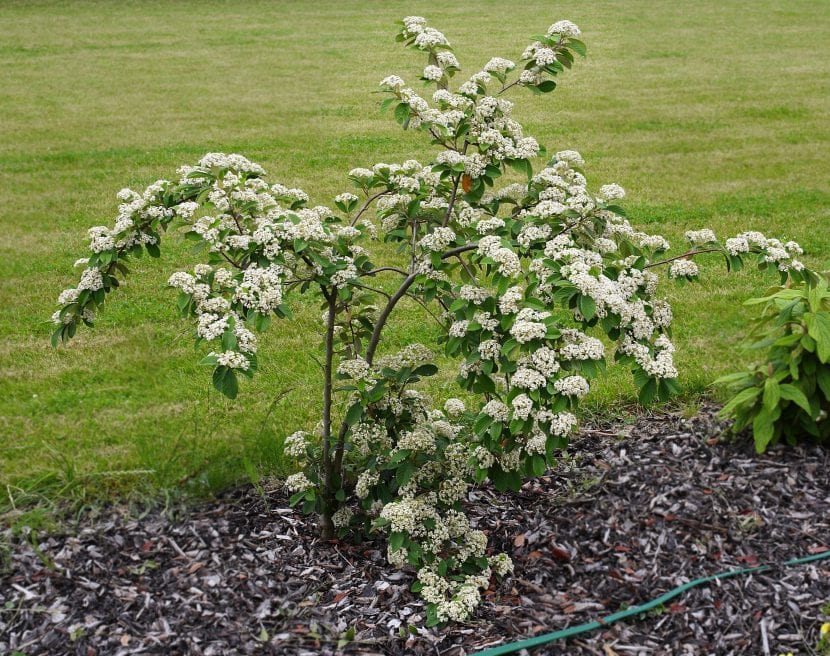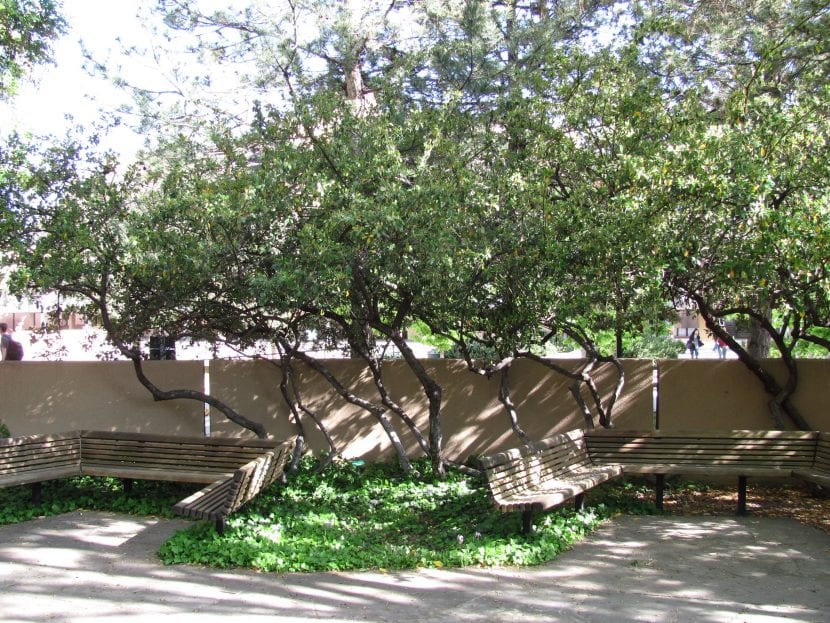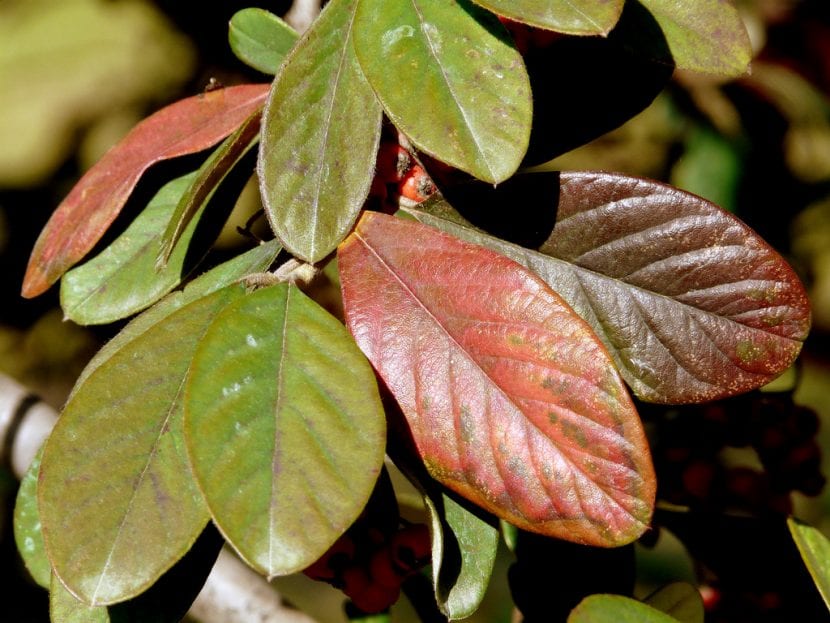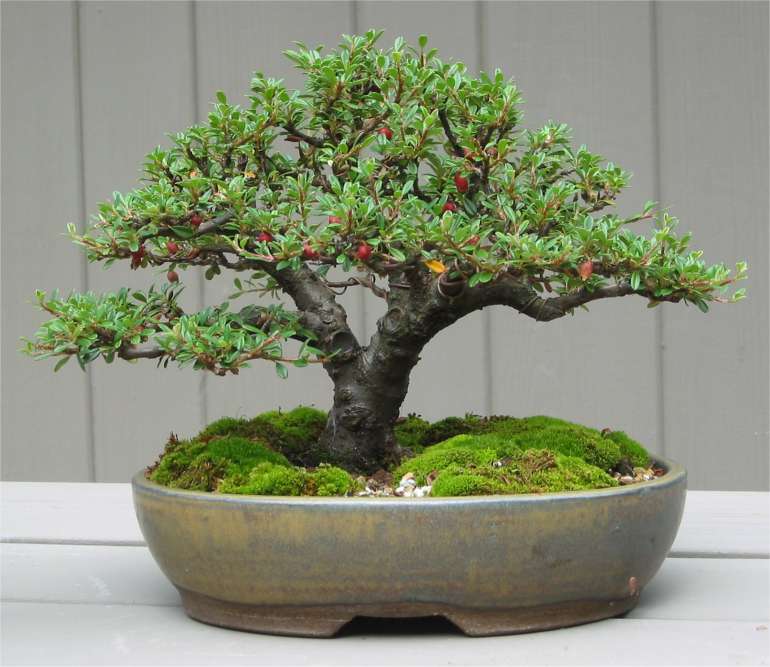
There are many shrubs that produce showy flowers, but few that resist pruning as well and are adaptable as the Cotoneaster lacteus. As it does not grow much, it can be grown both in pots and in the garden, since it is also not difficult to maintain.
With a minimum of attention we will brighten up the garden or patio every year. And to achieve it, you just have to follow our advice 🙂.
Origin and characteristics

Our protagonist is an evergreen shrub whose scientific name is cotoneaster coriaceus, although that of Cotoneaster lacteus. It reaches a height of 4 meters, and a width of 4m. The branches are generally arched, but as you can see in the photo, it can be made to have a tree bearing by pruning.
The leaves are 3-6cm long, dark on the upper surface, and with a light fuzz on the underside.. As they reach senescence (old age) they acquire a very beautiful reddish color. And it is that although it is an evergreen species, this does not mean that it never renews the foliage; in fact, it is something that he does throughout the year, little by little.
The flowers are white and are grouped in inflorescences. The fruit is ovoid, small, reddish in color, and contains two seeds.
What are their cares?

If you want to have a copy, we recommend that you provide it with the following care:
Location
Place your Cotoneaster lacteus outside, in full sun. It can also be in semi-shade as long as it gets a minimum of 4 hours of direct sunlight.
Earth
- Flower pot: universal culture substrate mixed with perlite in equal parts.
- Garden: it is indifferent as long as it is fertile and has good drainage.
Irrigation
The frequency of watering will vary depending on the weather and location, but in principle it is advisable to water it about 3 times a week in summer and every 4-5 days the rest of the year. It is recommended to use rainwater or lime-free.
Subscriber
Food is just as important as water for it to grow and stay healthy. So, from the beginning of spring to the end of summer it is advisable to pay it with ecological fertilizers once a month. If you have it in a pot, use liquid fertilizers so that the substrate does not lose the ability to filter water.
Multiplication

It multiplies by seeds or by cuttings. Let's see how to proceed in each case:
Seeds
The seeds need to cool before germinating, so sowing is divided into two phases:
1st phase - Stratification in winter
- The first thing to do is fill a tupperware with vermiculite previously moistened with water.
- Then the seeds are placed.
- Afterwards, sprinkle with copper or sulfur to prevent the appearance of fungi.
- They are then covered with a layer of vermiculite.
- The next step is to cover the tupperware and put it in the fridge for 2-3 months during which time once a week we will have to open it so that the air is renewed and see how the seeds are doing.
2nd phase - Pot planting
- After the winter, a pot of about 10,5 cm in diameter is filled with universal growing substrate and watered.
- Afterwards, a maximum of 2 seeds are placed on the surface.
- Then, they are covered with a layer of substrate.
- Next, sprinkle with copper or sulfur.
- Finally, the pot is placed outside, in full sun.
Thus, will germinate in 1 month or 2 at most.
Cuttings
To multiply by Cotoneaster lacteus by cuttings only you have to cut a branch that measures about 40cm at the end of winter, impregnate the base with homemade rooting agents or liquid rooting hormones, and plant it in a pot with vermiculite in semi-shade.
After 1 month we will have a new plant.
Pruning
At the end of winter, dry, diseased, weak or broken branches should be removed.. It is also a good time to give it the shape we want. Of course, it is very important to use appropriate pruning shears and that we disinfect them before and after using them.
Pests

It can be affected by the following:
- Mealybugs: they can be cottony or limpet-like. They feed on the sap, although they can be eliminated with anti-mealybug insecticides.
- White fly: they are insects that feed on the sap especially on new leaves. It is controlled / fought with yellow sticky traps.
- Cotoneaster moth: attacks between late spring and late summer. The leaves are covered with threads from a dark brown caterpillar of a moth, either Scythropia crataegella or Numonia suavella. It is removed with permethrin.
- Aphids: They are brown, yellow or green insects that feed on the sap. They are removed with yellow sticky traps.
Management
If overwatered the mushrooms they can seriously harm you. If the leaves appear with spots, the waterings will be spaced and the plant will be treated with fungicides.
Rusticity
It is a very resistant shrub, capable of withstanding frosts of up to -15ºC. In addition, it withstands heat well (35-38ºC) if you have a regular water supply.
What uses does it have?
El Cotoneaster lacteus It is a very decorative plant that is used both as an isolated specimen and in groups. If we do not have a garden, it can also be worked as bonsai.
Cotoneaster bonsai care

- Location: full sun.
- Substratum: 70% akadama + 30% kiryuzuna.
- Irrigation: every 1-2 days in summer, and every 3-4 days the rest of the year. Do not spray leaves, flowers, fruits or trunk.
- Subscriber: from early spring to late summer with specific bonsai fertilizers, following the instructions specified on the package. Do not pay if you have just transplanted or if you are sick.
- Transplant: every 2-3 years, in early spring.
- Pruning: can be pruned throughout the year, trimming branches that are growing too much.
And with this we are done. What did you think of the Cotoneaster lacteus?